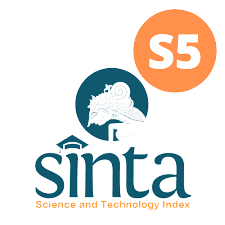PROFIL KEMAMPUAN BERPIKIR KREATIF PESERTA DIDIK KELAS VI DITINJAU DARI PRESTASI AKADEMIK
DOI:
https://doi.org/10.33061/js.v5i1.7533Keywords:
creative thingking, reviewed, academic achievementAbstract
This study aims to determine the profile of the creative thinking ability of class VI students of SD Negeri Gandekan No. 230 Surakarta who have below-average and above-average academic achievements. This research includes quantitative research. Data are collected by means of observation, interviews, and tests. The study sample was 34 learners. To determine the profile of students' creative thinking ability, this study used discriptive analysis. Meanwhile, to find out the difference in creative thinking ability between students who have academic achievements above and below average, using an independent T-Test analysis. The results showed that the creative thinking of students in kategori was good (71.38). With the following details: fluency indicators in the good category (78), flexibility in the good category (75.5), originality in the good category (73) and elaboration in the sufficient category (61). The T-Test value is sig.0.52>0.05 which means that the ability to think creatively between outstanding learners ak ademik up and down is considered to have no significant difference.
References
Aizikovitsh, E. & Amit, M. (2011). Developing the skills of critical and creative thinking by probability teaching. Procedia- Social and Behavioral Sciences, 15, 1087-1091
Asmara, R., Susantini, E., & Rahayu, Y. S. 2017. Pengembangan Perangkat Pembelajaran Biologi Berorientasi Pendekatan Tasc (Thinking Actively In Social Conteks) Untuk Melatihkan Keterampilan Berpikir Kreatif Siswa. JPPS (Jurnal Penelitian Pendidikan Sains), 5(1): 855-891.
Florida, R., Mellander, C., & Karen, K. (2015). THE GLOBAL CREATIVITY INDEX 2015. http://martinprosperity.org/media/Global-Creativity-Index-2015.pdf
Garaigordobil, M. & Berrueco, L. (2011). Effects of a Play Program on Creative Thinking of Preschool Children. The Spanish Journal of Psychology, 14 (2): 608-618
Kusnia Patmawati dkk. 2019. Profil Kemampuan Berfikir Kreatif Ditinjau Dari Kemampuan Akademik Mahasiswa. Edu Sains Jurnal Pendidikan Sains & Matematika 7(2): 11–18. doi: 10.23971/eds.v7i2.1386.
Melia, K. (2016). Pengaruh Kemampuan Berpikir Kreatif dan Positif terhadap Prestasi Belajar Matematika. Jurnal Kajian Pendidikan Matematika, 02(01): 57–68.
Munandar, Utami. 2012. Pengembangan Kreativitas Anak Berbakat. Jakarta: Rineka Cipta.
Permendikbud Nomor 21 Tahun 2016 tentang Standar Isi Pendidikan Dasar Dan Menengah
Siswono, T. Y. E. 2011. Level of Student’s Creative Thinking in Classroom Mathematics. Departement of Mathematics, Surabaya State University. Academic Journals. Vol.6 (7): 551
Supardi. (2012). Peran Berpikir Kreatif Dalam Proses Pembelajaran Matematika. Jurnal Formatif, 2(3): 248–262.
Rahayu, Susanto & Yulianti. (2011). Pembelajaran Sains dengan Pendekatan Keterampilan Proses Untuk Meningkatkan Hasil Belajar dan Kemampuan Berpikir Kreatif Siswa. Jurnal Pendidikan Fisika Indonesia. 7 (2011): 106-110
Sahwari dan Dassucik. (2020). Pengaruh Kemampuan Berpikir Kreatif terhadap Hasil Belajar Siswa pada Mata Pelajaran Matematika SMP Negeri 5 Panji Kabupaten Situbondo. JURNALIKA : Ikatan Alumni PGSD UNARS. 9 (1): 284-295.
Tran T B L, Ho T N, Mackenzie S V & Le L K. (2017). Developing assessment criteria of a lesson for creativity to promote teaching for creativity. Thinking Skills and Creativity. 25. 10-26
Treffinger, D. J., & Isaksen, S. G. (2005). Creative Problem Solving: The history, development, and implications for gifted education and talent development. Gifted Child Quarterly. 49(4), 342–353. https://doi.org/10.1177/001698620504900407
Downloads
Published
Issue
Section
License
Copyright (c) 2022 Jurnal Sinektik

This work is licensed under a Creative Commons Attribution-NonCommercial 4.0 International License.
Authors who publish this journal agree to the following terms:
- Authors retain copyright and grant the journal right of first publication with the work simultaneously licensed under a Creative Commons Attribution License that allows others to share the work with an acknowledgement of the work's authorship and initial publication in this journal.
- Authors can separately make additional contractual arrangements for non-exclusive distribution published by the journal (e.g., publish it in a book), with an acknowledgement of its initial publication in this journal.
- Authors are allowed and encouraged to send their work via online (e.g., in the institutional repositories or their website) after published by the journal.














